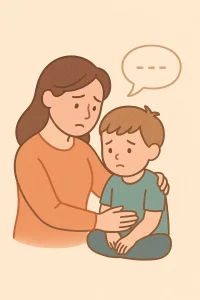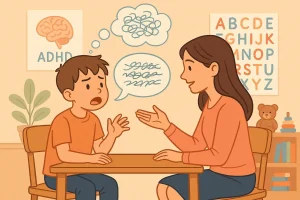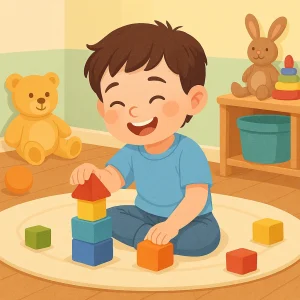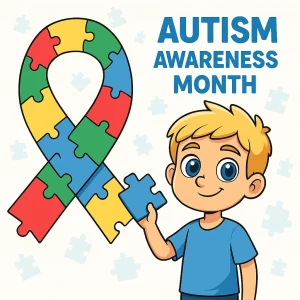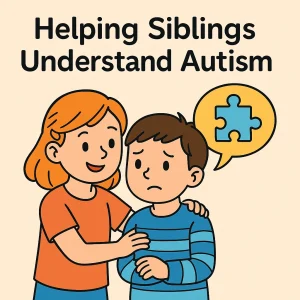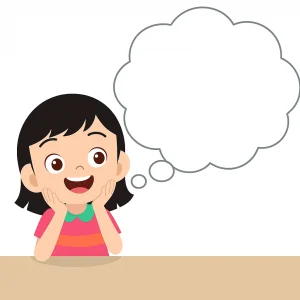WH Questions for Kids with Autism: A Parent-Friendly Guide
By Rajini D
Last Updated: February 11, 2025
Welcome to our guide on WH questions and their role in enhancing communication for children with autism. These foundational questions—Who, What, Where, When, Why, and How—aren’t just about gathering information; they’re key to helping autistic children express themselves and engage with the world around them. This article offers easy-to-implement strategies to incorporate these questions into daily interactions, fostering both understanding and growth in your child’s communication skills. Let’s explore how these simple queries can open doors to richer conversations and stronger connections.
What is Autism?
Autism Spectrum Disorder (ASD) is a complex developmental condition that involves persistent challenges in social interaction, speech, and nonverbal communication. There is no one type of autism but many subtypes, influenced by genetic and environmental factors. Each individual with autism has a distinct set of strengths and challenges.
The way autism affects communication can vary widely. Some children might be verbally skilled but could struggle with understanding the give-and-take of everyday conversation. Others might have very limited speech but can learn to communicate effectively using other means, such as pictures or sign language. This diversity means that each child’s autism is unique; hence, personalized approaches in therapy and education are crucial.
For many children with autism, learning how to frame and understand WH questions—Who, What, When, Where, Why, and How—can be particularly beneficial. These questions are essential tools for them to navigate social contexts and enhance their ability to communicate their needs, thoughts, and feelings. Recognizing this, we focus on tailored communication strategies at Wellness Hub that cater to the varied needs of autistic children, helping them to better connect with the world around them.
Also read: WH Questions for Speech Delay: Practical Strategies for Parents
The Role of WH Questions in Autism Communication
WH questions are more than just components of speech; they are essential tools that can significantly enhance the way children with autism interact with the world. Understanding and using “Who,” “What,” “When,” “Where,” “Why,” and “How” effectively can open up new avenues for communication and foster better cognitive processing skills in autistic children.
1. Developing Communication Skills
For autistic children, WH questions help bridge the gap between knowing language and using it functionally. These questions encourage them to form responses based on their observation and understanding, which is a crucial step in active communication. For instance, asking “What color is your shirt?” requires the child to not only process what is being asked but also to observe, evaluate, and then communicate their answer. It’s a simple question that supports complex cognitive skills.
2. Enhancing Cognitive Processing
Each WH question type serves a different cognitive function:
- Who questions improve social recognition.
- What and Where questions enhance object and spatial awareness.
- When questions develop a sense of time.
- Why and How questions foster causal thinking and problem-solving abilities.
Types of WH Questions
Understanding the different types of WH questions is crucial for tailoring communication and educational strategies to the needs of children with autism. These questions each serve specific purposes and support various aspects of language development and cognitive skills. Here’s a detailed look at each type and how they can be effectively utilized:
1. Who (Identifying People)
- Purpose: Helps children recognize and differentiate between people by name, relationship, or role.
- Example: “Who is your teacher?” This question encourages children to think about the individuals around them and their relationships.
- Cognitive Skill: Enhances social recognition and interpersonal understanding.
2. What (Identifying Objects or Actions)
- Purpose: Aids in labeling objects and describing actions.
- Example: “What is this?” while pointing to an object like a book or “What are you doing?” when a child is playing.
- Cognitive Skill: Supports vocabulary expansion and action recognition, critical for everyday interactions and learning environments.
3. Where (Identifying Locations)
- Purpose: Develops spatial awareness by associating objects and people with places.
- Example: “Where is your backpack?” This question helps children understand location and the concept of spatial organization.
- Cognitive Skill: Builds understanding of environments and aids in navigation, both physically and conceptually.
4. When (Understanding Time-Related Concepts)
- Purpose: Introduces concepts of time, sequencing, and temporal cues.
- Example: “When is your birthday?” or “When do we eat lunch?” These questions help children grasp the flow of daily activities and the importance of timing.
- Cognitive Skill: Encourages the development of time management and the ability to anticipate future events.
5. Why (Reasoning and Cause-Effect Relationships)
- Purpose: Fosters reasoning abilities by connecting actions with outcomes.
- Example: “Why do we brush our teeth?” By answering this, children learn to link habits with reasons, enhancing their understanding of cause and effect.
- Cognitive Skill: Critical for developing problem-solving skills and understanding the rationale behind rules or routines.
6. How (Describing Processes and Methods)
- Purpose: Explains the manner in which things are done or how events occur.
- Example: “How do you tie your shoes?” This question requires a step-by-step explanation, which helps children articulate processes and sequences.
- Cognitive Skill: Essential for mastering task execution and articulating sequences, which are vital for both academic tasks and daily life skills.
Learn More: How WH Questions Help Kids Improve Their Communication Skills
Why WH Questions are Crucial for Autism Communication
WH questions are not just basic elements of speech; they are powerful tools that can significantly enhance the development and daily interactions of children with autism. Understanding the “who,” “what,” “where,” “when,” “why,” and “how” helps these children navigate their social and learning environments more effectively. Here’s a closer look at the specific benefits of each type of WH question and how mastering them can lead to improved social interactions and learning outcomes.
Impact of WH Questions on Communication and Development in Autism
| WH Question | Benefit | Real-life Example |
|---|---|---|
| Who | Helps children identify and remember different people in their lives, crucial for forming relationships. | When a child learns to ask and answer “Who” questions, they can engage more meaningfully with peers and adults, recognizing names and roles, which is fundamental in social settings like school or family gatherings. |
| What | Enables children to inquire about the world around them, leading to a broader vocabulary and better understanding of objects and their uses. | A child asking, “What is this?” while pointing to a new toy learns not only the name of the toy but also its purpose, enhancing both language skills and cognitive development. |
| Where | By mastering “Where” questions, children improve their ability to comprehend and articulate spatial relationships. | Understanding and responding to questions like “Where is your school?” helps a child describe locations and directions, which are essential for independence and safety in navigating their environments. |
| When | “When” questions foster an understanding of time, routine, and the sequencing of events, vital for daily planning and anticipation. | Answering “When is lunch?” helps a child understand time-related concepts, aiding them in adapting to schedules and routines, reducing anxiety about the unknown. |
| Why | These questions encourage logical thinking and the ability to connect cause and effect, critical for problem-solving and understanding social cues. | Responding to “Why do we wear coats?” allows a child to think about reasons and consequences, linking actions with appropriate responses to environmental cues. |
| How | “How” questions require a detailed explanation of processes, which helps in developing detailed speech patterns and the ability to follow and give instructions. | Learning to answer “How do you play this game?” not only teaches a child the rules but also how to articulate them clearly to others, facilitating cooperative play and learning. |
How to Introduce WH Questions to Autistic Children
Introducing WH questions to children with autism is a valuable step in enhancing their communication skills. This process can be tailored to each child’s developmental level and communication needs, ensuring that they not only understand the questions but are also able to use them effectively in conversation.
Here’s a step-by-step guide to help you create a supportive learning environment that fosters curiosity and language development.
1. Assess the Child’s Current Communication Skills
- Begin by observing the child’s ability to respond to simple questions and their current use of language. This assessment will help tailor the introduction of WH questions to their specific capabilities.
- Tip: Use daily interactions as informal assessment opportunities to note which types of questions the child responds to best.
2. Start with Concrete Questions
- Introduce WH questions that are concrete and relate directly to the child’s environment or activities. Start with “what” and “who” questions, as these typically require straightforward answers about familiar objects and people.
- Example: While looking at a book with the child, ask, “What is this?” (pointing to an object) or “Who is this?” (pointing to a character).
3. Use Visual Aids
- Support the learning process with visual aids like pictures, flashcards, or objects. Visuals can help the child understand the concept of the questions and provide a reference for forming answers.
- Tip: Create a set of flashcards with pictures representing different WH questions. For instance, a picture of a playground for “Where do you play?”
4. Incorporate Into Daily Routines
- Regularly integrate WH questions into daily routines. Consistency helps reinforce understanding and the practical use of these questions.
- Example: During mealtime, ask, “What are you eating?” or “Where did you put your cup?”
5. Gradually Increase Complexity
- As the child becomes more comfortable with basic WH questions, gradually introduce more complex questions like “why” and “how,” which require deeper thinking and explanation.
- Tip: Begin with cause-and-effect situations that are directly observable. For example, ask, “Why do we wear a coat?” when it’s cold outside.
6. Practice and Positive Reinforcement
- Encourage practice by turning question-and-answer sessions into a game that rewards the child for their efforts and correct answers. Positive reinforcement can be verbal praise, stickers, or a favorite activity.
- Tip: Use a reward chart to track progress and provide visual feedback on the child’s achievements.
7. Encourage Spontaneity
- As skills develop, encourage the child to ask their own WH questions. This promotes curiosity and the ability to initiate conversation, which are crucial for social interaction.
- Example: Prompt the child with scenarios that might elicit questions, like setting up a play scene with toys or planning a fun activity.
Lear More: WH Questions for Kids: Printable Worksheets and Games
Interactive Games and Activities to Practice WH Questions
Engaging in interactive games and activities is an effective way to teach WH questions to children with autism. These methods make learning enjoyable and help reinforce the practical application of questions in various contexts. Here, we explore some of the best activities that incorporate Wellness Hub’s resources to enhance learning outcomes.
Role-Playing Games
Role-playing is a dynamic way to practice WH questions by simulating real-life scenarios. It allows children to understand and use these questions in practical, everyday situations, thereby improving their communication and social skills.
Examples of Role-Playing Scenarios:
- Doctor’s Visit: Create a role-play scenario where one person is the doctor and the child is the patient. Use questions like, “What is your name?” “How are you feeling today?” and “Where does it hurt?” This helps the child practice answering personal and health-related questions.
- Shopping Trip: Set up a pretend store with various items. The child can be the shopper or the cashier. Incorporate questions like, “What would you like to buy?” “How much does this cost?” and “Who is this for?” This scenario teaches object recognition and transaction-based interactions.
- Classroom Setting: Simulate a classroom environment where the child can be a student or the teacher. Ask questions such as, “Who is your best friend?” “What is your favorite book?” and “Why do you like it?” This encourages sharing personal preferences and understanding others’ perspectives.
Picture-Based Activities
Picture books and story cards are excellent tools for practicing WH questions. They provide visual context that helps children with autism process and answer questions more effectively.
How to Use Picture Books and Story Cards:
- Picture Book Walk-Through: Before reading a story, flip through the pictures with the child and ask questions about what they see. For example, “Who is this character?” “What are they doing?” and “Where are they going?” This activity prepares the child to connect the story’s text with visual elements.
- Story Cards Sequence: Use story cards to tell a story in sequence. After laying out the cards, ask the child to describe what happens using WH questions, like “What happens first?” “Why did the character do that?” and “How did the story end?” This helps in understanding sequence and causality.
- Create Your Own Story: Have the child create their own story using a mix of story cards. They can then ask and answer their own WH questions about the story they’ve created. This not only enhances their ability to question and respond but also boosts creativity.
Conclusion
WH questions are vital tools that help children with autism improve their communication and understanding of the world. Through fun activities like role-playing and using picture books, children learn to interact better and express themselves more clearly. At Wellness Hub, we provide resources tailored to meet these needs, supporting each child’s unique journey. Explore our helpful guides and tools here to enhance your child’s learning process. Remember, every question they learn to ask and answer opens up new possibilities for growth and connection. Join us in empowering your child, one question at a time.
Frequently Asked Questions:
1. What are WH questions and why are they important for autism?
WH questions include “who,” “what,” “where,” “when,” “why,” and “how.” They are crucial for developing communication skills in children with autism, helping them understand and interact with their surroundings more effectively.
2. How can I start teaching WH questions to my child with autism?
Begin with simple questions that relate to familiar objects or people, and use clear, visual aids like flashcards or picture books to help your child understand and respond.
3. What types of WH questions should I teach my child first?
What types of WH questions should I teach my child first? Start with “what” and “who” questions as they are the easiest for children to understand and answer. These questions can be about familiar items and people around them.
4. Can WH questions help my autistic child develop better social skills?
Yes, mastering WH questions can significantly improve social interactions for your child, as these questions are essential for everyday conversations and social exchanges.
5. What are some effective games to teach WH questions to children with autism?
Yes, mastering WH questions can significantly improve social interactions for your child, as these questions are essential for everyday conversations and social exchanges.
6. Why is it important to use visuals when teaching WH questions to children with autism?
Visual aids like pictures and story cards help children with autism process information more easily and provide a concrete context that enhances understanding and response accuracy.
7. How often should I practice WH questions with my child?
Regular practice is key. Integrate WH questions into daily routines to make them a natural part of your child’s communication.
8. What should I do if my child struggles with answering WH questions?
Be patient and encourage any attempt to respond. Use simpler questions or more direct visuals, and consider consulting a speech therapist for tailored strategies.
9. Can learning WH questions improve my child’s academic performance?
Yes, as WH questions enhance comprehension and communication skills, they can contribute positively to your child’s learning and performance in school settings.
10. Where can I find resources to help with teaching WH questions to my child with autism?
Visit Wellness Hub’s resources page for tailored educational tools and guides designed to help children with autism learn WH questions effectively.
About the Author:
Rajini Darugupally
M.Sc., Speech-Language Pathologist (9+ years of experience)
Rajini is a passionate and dedicated Speech-Language Pathologist with over 9+ years of experience, specializing in both developmental speech and language disorders in children and rehabilitation in adults. Driven by a desire to empower each individual to find their voice, Rajini brings a wealth of experience and a warm, genuine approach to therapy. Currently, at Wellness Hub, she thrives in a team environment that values innovation, compassion, and achieving results for their clients.
Book your Free Consultation Today
Parent/Caregiver Info:
Client’s Details:
* Error Message

